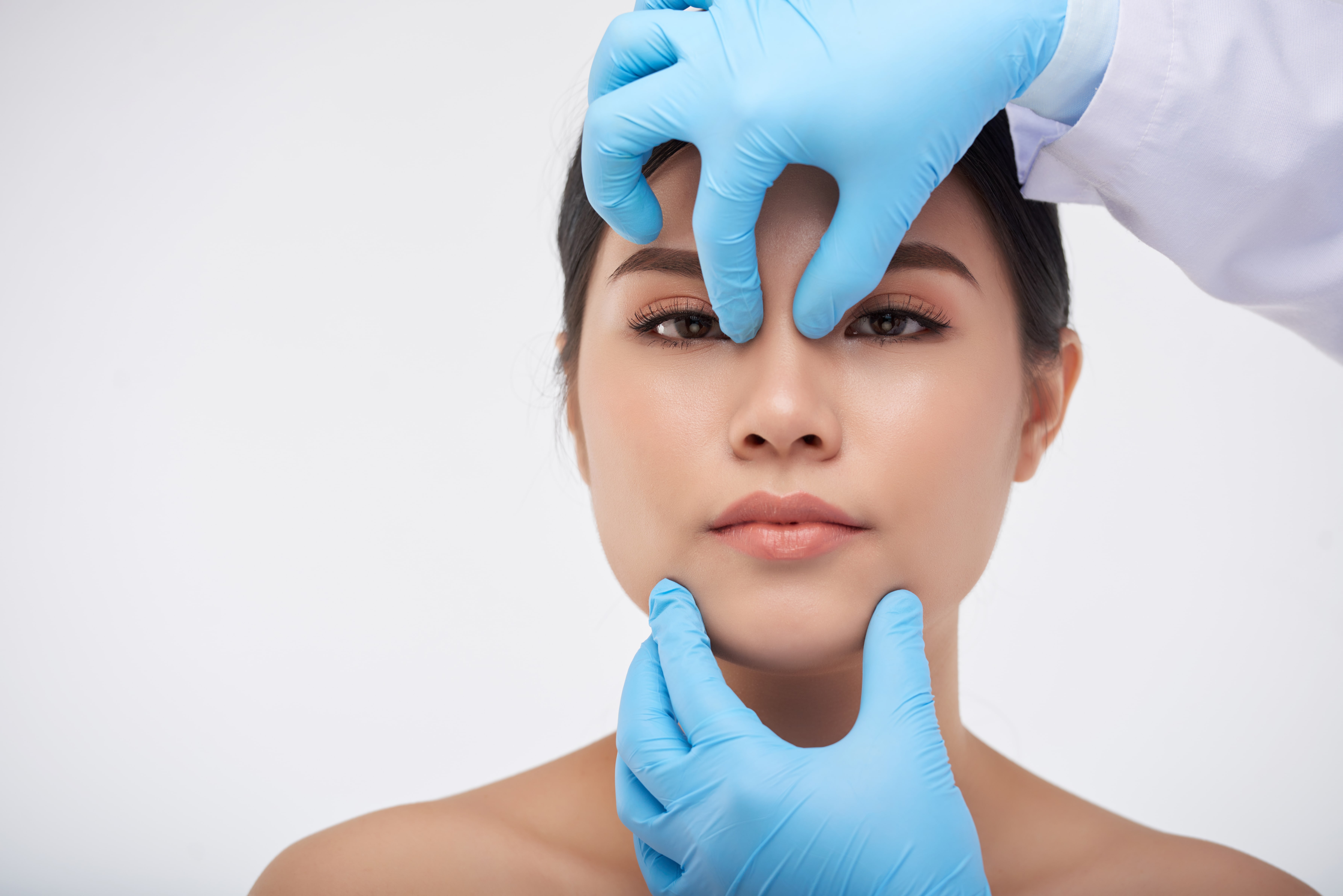Why have a Rhinoplasty?
The facial appearance is the calling card and creates the first impression, the size, and shape of the nose plays a significant role in the appeal of your face.
The talented hands of Dr. Serbülent Güzey make it possible, to create a more balanced, harmonious facial appearance by changing the shape, size, or contour of the nose.
- You might consider a Rhinoplasty to:
- Bring the size and shape of the nose in relation to facial balance
- Correct visible humps or depressions on the bridge of the nose or fix nasal asymmetry
- Improve the size and position of the nostrils
- To improve your breathing
“In Rhinoplasty surgery there are two different approaches: open and closed rhinoplasty. Each technique has its own set of advantages and disadvantages. I decide on the approach due to my examinations. My personal preference is mostly closed rhinoplasty because of less swelling and a faster recovery period. In very complex cases (secondary rhinoplasty or severely traumatized nose reconstruction) I prefer the open rhinoplasty technique which allows me to work with more precision as I alter the nasal structures.”. – Serbülent Güzey
Who is a good candidate for a Rhinoplasty?
Rhinoplasty can be a great option for an aesthetic improvement or to resolve breathing problems; however, certain patients are better suited to the procedure, and it is important to have realistic expectations about the surgery, recovery, and results. In general, you are likely a good candidate for a Rhinoplasty if you agree with the following:
- You are in good overall physical and mental health.
- You have realistic expectations of the outcome
- You have a crooked septum that makes the nose appear off-center
- You have a bump on the bridge of the nose
- You have a wide nose or a thick, asymmetric, overly projecting, or even drooping nasal tip
- You have cosmetic irregularities due to injury or trauma
- You have the ability to properly rest and recover post-surgery as you won’t be able to perform certain tasks
- You are at least 18 years old
If you desire a more symmetrical nose, keep in mind that everyone’s face is asymmetric to some degree. Results may not be completely symmetric, although the goal is to create facial balance and correct proportion.
To undergo a Rhinoplasty, you’d have to be able to plan a stay of 6 days in Istanbul.
Open vs. Closed Rhinoplasty
There are two different approaches to reshaping the nose, each technique has its own set of advantages and disadvantages. An open (external) rhinoplasty, is usually performed in cases of revision rhinoplasty (because the original structure of the nose has already been disturbed) if the patient’s nose is crooked or to achieve a marked reduction in nasal tip projection.
The procedure typically performed by making a small incision on the columella (the soft tissue which separates the nostrils). This technique allows easy access and a clearer view to the underlying bone and cartilage structure.
The scar left behind is barely visible and will usually fade with time. A closed (endonasal) rhinoplasty, is performed by making all necessary incisions through separate surgical openings completely hidden within the left and right nostrils. With no external incisions, the closed technique is less invasive and creates no visible scarring, at all.
For many of the changes made during rhinoplasty, the lack of the columellar incision results in less swelling and a faster recovery period Dr. Serbülent Güzey can achieve equal results using a closed approach than an open approach. He uses the closed approach in over half of his primary rhinoplasties.
Rhinoplasty Consultation
The consultation begins with taking your photographs for our medical archive.
Then Dr. Serbülent Güzey will examine the nose and plans the best course of action to take for your rhinoplasty to achieve the most attractive result.
In some cases, Dr. Serbülent Güzey uses a surgical marker to do markings which will assist him during the surgery.
During your consultation, he answers all your questions, listens, and understands your expectations and makes the planning based on your desires regarding the size and shape.
What is involved in Rhinoplasty Surgery?
A Rhinoplasty surgery is performed under general anesthesia and begins with the incision which is either inside the nose or across the columella. Through these incisions, the skin that covers the nasal bones and cartilages is gently raised, allowing access to reshape the structure of the nose by removing bone or cartilage and/ or placing cartilage grafts (commonly from the septum, occasionally from the ear, rarely from the rib).
If the septum deviates, it can be straightened and the projections inside the nose reduced to improve breathing.
Once the underlying structure of the nose is sculpted to the desired shape, nasal skin and tissue are dropped and incisions are closed.
Dr. Serbülent Güzey will place a nasal cast/ external splint on the exterior of your nose and internal splint into the nasal cavities to maintain the new shape of the nose.
The duration of the surgery is 1,5-2 hours.
After Rhinoplasty
After the surgery you will have external and internal nasal splints, the internal splints get removed 3 days after surgery, the external one about 5 days after surgery (the day before you leave).
There will be prominent bruising and swelling of the face and nose. Expect to see red and swollen eyes as well as bloody discharge out of the nose due to the procedure.
Patients should start light walking shortly after surgery – nothing strenuous, just short walks around the room every other hour. It is good for the circulation and helps prevent blood clots.
Our patients will stay in the hospital for one night after the surgery and get discharged on the following day.
While pain is typically minimal and easily controlled through pain medication, you shouldn’t bend or exert yourself physically, lay and sleep with your head elevated above your heart and put some ice on your face to bring down the swelling.
The first body shower can normally be taken on the day after surgery. As soon as the external splint got removed from your nose and replaced with a taped dressing (which will stay another 7 days) you can also wash your face.
You should be able to resume light daily activities a few days after your surgery and return to work within 7 to 10 days.
Aftercare of Rhinoplasty
For the fastest recovery and best results, it’s essential for you to take special care of your nose and body in the first days and weeks after your Rhinoplasty.
Internal and external nasal cast/ splint
Both of them are placed to maintain the new shape of your nose.
The internal splints (inside the nasal cavities) will get removed 3 days after your surgery, after that, you will be able to breathe much better.
The external splint (on top of the nose) will get removed about 5 days after your surgery/ the day before you leave and replaced with a taped dressing (which will stay another 7 days).
Wound care
You will be supplied with a comprehensive packet of post-operative wound care utils as well as the instructions, explaining how to take care of the wounds and how to use the saline nasal spray and the antibiotic cream which we provide for you.
Be sure to follow these instructions to ensure a healthy wound recovery and eliminate potential risks.
Nutrition
Adequate hydration (drinking plenty of water) and a healthy diet are essential as aftercare for good healing of your Rhinoplasty. Limit your diet to light, bland foods for the first few days following your procedure. If you don’t experience any difficulties, you can move onto heavier, tastier foods. Avoid foods and spices that have been known to cause you sneezing or other reactions.
Exercise After Rhinoplasty
After your Rhinoplasty, you should take light walks as soon as possible after surgery as a light cardiovascular activity to help your lymphatic system work properly and better.
After three weeks you can resume light cardio without heavy lifting. From the fourth week on, you can resume weight training, etc. with minimal bending over. Contact sports should be avoided until 6 weeks or more post-op.
Life After Rhinoplasty Surgery
While initial swelling subsides within weeks and months after your rhinoplasty, it may take up to a year for your new nasal contour to fully refine. During this time, you may notice gradual changes in the appearance of your nose as it refines to a more permanent outcome. The swelling may also come and go and worsen in the morning during the first year following your rhinoplasty surgery. In the first 6 weeks, you should avoid wearing glasses and the following 3-6 months avoid any trauma (application of force) to your nose. Numbness in the tip of the nose, upper front teeth or roof of the mouth following surgery is to be expected because nasal surgery typically causes a temporary disruption of some of the nerves in the area. Sensation will generally return slowly over a period of several weeks, and rarely, months.


